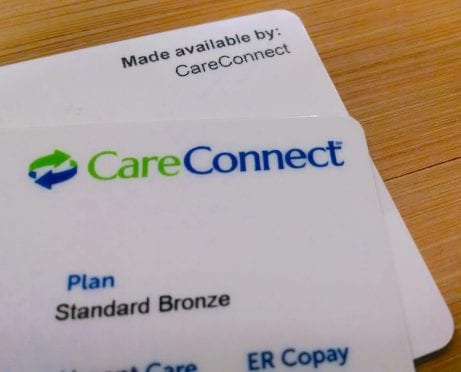
A while back, my adult son called and asked for some advice. He wasn’t feeling well and was leaving for an international trip in just three days. It was the normal stuff — fever, sinus pain, an incessant cough. In fact, he felt so ill that he had come home from work. He tried some over-the-counter meds, but they just weren’t working. He continued to get worse.
The problem? He and his wife had just moved to Chicago, and they hadn’t found a family doctor yet. It would take either weeks to get an appointment or untold hours waiting in an urgent care clinic or emergency room.
When my son called, I happened to remember hearing something about a company called Doctor On Demand. It’s a telemedicine company co-founded by Dr. Phil and his son, Jay McGraw. What does that mean? Well …
Compare Health Insurance Plans to Get the Best Price — Get a Free Quote Here >>
What Is Telemedicine?
Telemedicine is a way for you to see a doctor without having to leave the house.
With Doctor On Demand and other companies like Teladoc and American Well, you simply download their free app, fill out a medical questionnaire, and then wait for your doctor to appear on the screen.
My Son’s Experience With Doctor On Demand
When my son used the service, he waited less than five minutes.
The doctor was knowledgeable and professional. She asked lots of questions and diagnosed my son with sinusitis. She even directed the prescription to the pharmacy he had chosen on the medical form and let him know that it would be ready in an hour.
When my son called to let me know how the appointment went, he said, “I’m never going to the doctor’s office ever again!”
He said that the value in this type of health care was enormous. You don’t have to leave home when you feel terrible and he felt extremely well cared for by his doctor.
Pros and Cons of Telemedicine
Doctor On Demand also offers professional mental health services in the form of counseling. Melanie Lockert, a CentSai writer who specializes in mental health as it relates to finance, checked it out.
 “It seems like a great option for people who need help and don’t want to leave their home,” Lockert says. “I think access is key! On the other hand, I think there are community clinics that offer more generous sliding scale options.”
“It seems like a great option for people who need help and don’t want to leave their home,” Lockert says. “I think access is key! On the other hand, I think there are community clinics that offer more generous sliding scale options.”
So is telemedicine worth it? Can it really replace a traditional doctor’s appointment, in an office, with a physical examination?
“Unfortunately, because the doctor can’t examine you, there are times when you cannot be treated remotely and you must be referred to receive in-person care,” says Dr. Kyle Varner, a physician specializing in internal medicine. “The telemedicine industry is currently quite conservative, and remote doctors will likely expand the number and type of patients they see in the future.”
Compare Health Insurance Plans to Get the Best Price — Get a Free Quote Here >>
How Much Does It Cost?
Doctor on Demand quotes a starting price of $75 for a 15-minute consultation, with different costs for different lengths and types of consultations. However, the site emphasizes that if you have insurance, “the cost will vary depending on your plan.”
Meanwhile, HelloAlvin — a partner company of Teledoc — works with health insurance providers that include online doctor services. If you don't have insurance, you can get an appointment for $69. That fee will also give you unlimited access to Hello Alvin's 24-hour Registered Nurse Line and Email-a-Doctor services for 30 days after the appointment.
And there’s good news about insurance. Many large national carriers, including Aetna, Anthem, and UnitedHealthcare, cover virtual physician visits in urban and suburban areas, as well as for their rural beneficiaries, according to ModernHealthcare.com,
In fact, most major commercial insurers and self-insured employers will include some kind of telehealth benefit.
It’s even a centerpiece offering for some insurance startups like Oscar, and some telemedicine companies will work with employers and insurance providers to set up plans for their users.
“Copays and deductibles usually apply, but total out-of-pocket costs do not typically exceed $50 for a basic visit,” Varner says.
Some telemedicine companies even provide their own plans. For example, Teladoc has individual plans for $9.95 a month. If you're looking for new health insurance coverage, Agile Health allows you to compare plans, including those from telemedicine providers.
Is Telemedicine Worth It?
There are worries about the future of telemedicine in an industry that seems to be slow to progress.
“The biggest concerns for the future of telehealth are regulatory — there is a lot of fear in the industry that regulators may attempt to curtail the remote practice of medicine,” Varner says. “Any regulation of the telehealth industry would hurt patients by restricting their access to care and driving up prices. Regulation in medicine always gets sold as a way to protect patients, but it always seems to hurt them instead.”
But many people still want to see their regular physician in-person and will be unlikely to want to replace in-person care with a video or phone conference. Since telemedicine is new, its accuracy and reliability are still under scrutiny.
Caution is especially important for someone who has serious or chronic health conditions. However, if you're like me — who has had to see a doctor twice in the last five years — or if you live in a rural area where services aren't readily available, then telemedicine may still be worth it.
Compare Health Insurance Plans to Get the Best Price — Get a Free Quote Here >>
“We are using technology to dramatically lower the cost while at the same time improving the quality of care and the ease of accessibility,” Varner says. “Doctors like this because it is a more pleasant way to practice medicine. Patients love it because it saves them time and money while still giving them access to high-quality care.”
So for me, personally? An affordable price and I don’t have to leave my house? Sign me up!
Additional reporting by Jazmin Rosa and Evan Sachs.











